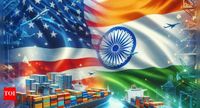Across the United States and India, the effects of escalating tariffs and shifting trade policies are rippling through economies, boardrooms, and households alike. On Saturday, July 19, 2025, the second wave of ‘No Kings’ demonstrations swept across American cities, with crowds larger than those seen in June. The message? A pointed rebuke of President Donald Trump’s perceived autocratic tendencies, his administration’s cutbacks to medical benefits, and the broader right-wing MAGA movement. Yet, beneath the chants and placards, the economic impact of Trump’s tariff-heavy approach is steadily coming into focus—both at home and abroad.
In the United States, the most immediate sign of change is hitting consumers where it hurts: their wallets. According to data from Kelley Blue Book, the average cost of a new car in the US topped $50,000 for the first time ever in September 2025—a 4% jump from the previous year. Experts attribute a significant portion of this sticker shock to Trump’s tariffs, which have ratcheted up costs for automakers and, inevitably, buyers. But cars aren’t the only items feeling the heat. Retail giants like Costco and Walmart have been raising prices on appliances, furniture, tools, and children’s items, reflecting the broader price pressures that tariffs are beginning to exert on the American consumer.
Despite these visible pain points, the broader US economy has shown surprising resilience—at least for now. The first half of 2025 saw annual economic growth of 1.1%. While that’s the slowest first-half growth since 2012 (excluding the pandemic-hit 2020), it’s not the economic cliff some had feared. The stock market, buoyed in large part by an artificial intelligence boom, continues to provide a cushion, especially for the wealthiest Americans. The top 10%—who have reaped the biggest gains from soaring tech stocks—are still spending robustly, propping up overall consumer demand.
But warning signs are mounting. On August 1, 2025, Erika McEntarfer, the Commissioner of the Bureau of Labor Statistics, was abruptly fired after her agency reported a dismal 73,000 new non-farm jobs in July. Even more troubling, the job numbers for May and June were revised sharply downward, to just 19,000 and 14,000, respectively. President Trump, in a familiar refrain, accused the agency of “rigging” the numbers to make him and his party look bad. The labor market, once a pillar of strength, is showing cracks that could widen if the tariff-driven slowdown deepens.
Tariffs, of course, are at the heart of this economic drama. Since January, the average US tariff has soared from 3% to an estimated 15-20%. Major trading partners such as the European Union, Japan, and South Korea now face tariffs of around 15%, while others—including Canada, Switzerland, Brazil, and India—are hit with rates as high as 35-50%. According to a Goldman Sachs estimate, about 51% of these tariffs have been absorbed by American businesses, eating into their profit margins. But the remaining costs are increasingly being passed on to consumers, meaning the pain is likely to grow in the months ahead.
IMF chief economist Pierre-Olivier Gourinchas noted last week that the relative stability so far is partly thanks to temporary factors: “The United States negotiated trade deals with various countries and provided multiple exemptions. Most countries refrained from retaliation, keeping instead the trading system largely open. The private sector also proved agile, front-loading imports and speedily re-routing supply chains.” But as the IMF warns, these are “temporary relief, rather than underlying strength in economic fundamentals.”
For many American importers, the scramble to beat tariff deadlines by front-loading shipments has kept shelves stocked and prices temporarily in check. Trump’s repeated waivers and extensions have also bought time, but with each passing month, more products on store shelves reflect the full brunt of the new tariffs. The coming Fall-Winter and Christmas shopping season could prove a turning point, as higher costs work their way through the system and potentially reshape voter sentiment ahead of the midterm elections.
Meanwhile, the Federal Reserve finds itself caught in a bind. Under pressure from President Trump, the Fed cut interest rates in September 2025, but now faces the dual threat of rising inflation and weakening job growth. The 10-year Treasury yield jumped above 4.2% after a lackluster $42 billion auction in August, underscoring investor nerves about America’s fiscal trajectory. As Fed Chair Jerome Powell tries to balance price stability with maximum employment, the unpredictable effects of tariffs make his job all the more challenging.
Across the globe, India is facing its own set of challenges—and opportunities—in this new era of tariff wars. Confronted with a sweeping 50% US tariff on its goods, India has embarked on an aggressive strategy to diversify its export markets. According to a recent Elara Capital report, this approach is paying off: India’s exports rose 6.7% year-over-year in September 2025, a dramatic turnaround from the 1% decline seen a year earlier. The second quarter of FY26 (July-September 2025) saw exports grow by about 9% year-over-year, compared to a 7% drop the previous year.
India’s merchandise trade deficit for the first half of FY26 (April-September 2025) stood at $155 billion, with exports at $220 billion (up 3% year-over-year) and imports at $375 billion (up 4.5%). Notably, exports to Spain, the UAE, China, and Bangladesh have shown steady gains, signaling a successful redirection of trade channels amid US-induced disruptions. Electronics exports surged by 50.5% year-over-year in September, rice shipments jumped 33.2% to $924.8 million, and marine products rose 23.4% to $781 million. Even gems and jewelry, a sector often sensitive to global shocks, grew modestly.
However, not all sectors are thriving. Labor-intensive industries—especially textiles—have struggled. Readymade garment exports fell 10.1% year-over-year to $997 million, while cotton and handloom exports dropped 11.7% to $930 million. India’s merchandise exports to the US specifically declined by 11.93% in September, reflecting the direct impact of Washington’s higher tariffs. Still, 24 countries, accounting for 59% of India’s total exports, registered positive growth during April-September 2025, evidence of the country’s successful diversification push.
Yet the path forward isn’t without obstacles. There’s a real risk that US tariffs could become permanent or expand to other product lines. Some exporters warn of the dangers of over-reliance on a few sectors—like electronics—where growth is concentrated among a handful of large firms. To sustain momentum, India will need to invest in trade infrastructure, improve logistics, and support small and medium enterprises that are struggling to adapt. As one exporter told PTI, “The trend will continue in the coming months as well,” with the exporting community pushing into Africa, Latin America, and the Middle East.
In a twist of economic fate, the Trump tariffs that were meant to punish foreign competitors are forcing countries like India to innovate, diversify, and invest for the long haul. Whether this global game of tariff chess ultimately benefits American workers or global competitors remains to be seen. What’s clear is that the world’s economic order is being reshaped in real time, and the consequences—intended and otherwise—are just beginning to unfold.

